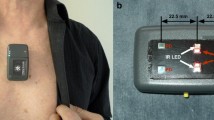Abstract
Objective.For determining the adequacy of ventilation, conventional pulse oximetry should be amended by PaCO2 (= arterial carbon dioxide partial pressure). This study investigates the precision of carbon dioxide measurements of the first digitalear-clip sensor providing continuous non-invasive monitoring of PaCO2, SpO2 (= functional arterial oxygen saturation as estimated with a pulse oximeter) and pulse rate and compares it to two conventional analog oximeters. Methods.30 hypoxemia episodes in 6 adult volunteers were investigated in a standardized protocol. Equipment: Masimo™ analog finger sensor, Nellcor™ analog ear sensor, SenTec™ digital ear sensor. Results.The difference between PCO2 data (= PaCO2 estimated from the measured PcCO2 based on an algorithm by Severinghaus) (PcCO2 = cutaneous carbon dioxide pressure) and the PaCO2 is clinically unimportant. Therefore, we suggest, the two methods of estimating patient's carbon dioxide status can be used interchangeably. Conclusions.Combined digital SpO2/PcCO2 ear sensors are very promising to allow for a fast and reliable monitoring of patient's oxygenation, hyper-/hypocapnia and ventilation with one single non-invasive probe. Optimal primary signal processing – amplification and digitalisation within the probe – allow for fast and reliable downstream signal processing algorithms. The resulting short SpO2 response times give the medical staff more time to take appropriate actions.
Similar content being viewed by others
REFERENCES
Severinghaus JW. The current status of transcutaneous blood gas analysis and monitoring. Blood Gas News 1998; 7(2): 4–9
Bohnhorst B, Peter CS, Poets, CF. Pulse oximeters' reliability in detecting hypoxemia and bradycardia: comparison between a conventional and two new generation oximeters. Crit Care Med 2000; 28: 1565–1568
Heuss LT, Schnieper P, Chhajed PN, Beglinger C. Safety monitoring during sedation with a smart clip at the ear lobe. Clinical Gastroenterology and Hepatology: submitted 2004
Severinghaus JW, Naifeh KH. Accuracy of response of six pulse oximeters to profound hypoxia. Anesthesiology 1987; 67(4): 551–558
Reynolds LM, Nicolson SC, Steven JM, Escobar A, McGonigle ME, Jobes DR. Infuence of sensor site location on pulse oximetry kinetics in children. Anesth Analg 1993; 76(4): 751–754
American Society for Testing and Materials (ASTM). Standard speci¢cation for alarm signals in medical equipment. West Conshohocken, PA. ASTM 1999; F1463–F1493
Hayoz J, Rohling R, Tschupp A.World's first combined digital pulse oximetry and carbon dioxide tension ear sensor. ISIAPO 2001; Meeting Abstract A6
Hamber EA, Bailey PL, James SW, Wells DT, Lu JK, Pace NL. Delays in the detection of hypoxemia due to site of pulse oximetry probe placement. J Clin Anesth 1999; 11: 113–118
Villanueva R, Bell C, Kain ZN, Colingo KA. Effect of peripheral perfusion on accuracy of pulse oximetry in children. J Clin Anesth 1999; 11(4): 317–322
Kirkham FJ, Hewes DK, Prengler M, Wade A, Lane R, Evans JP. Nocturnal hypoxaemia and central-nervoussystem events in sickle-cell disease. Lancet 2001; 357(9269): 1656–1659
Clark JS, Votteri B, Ariagno RL, Cheung P, Eichhorn JH, Fallat RJ, Lee SE, Newth CJ, Rotman H, Sue DY. Noninvasive assessment of blood gases. Am Rev Respir Dis 1992; 145(1): 220–232
Author information
Authors and Affiliations
Rights and permissions
About this article
Cite this article
Kocher, S., Rohling, R. & Tschupp, A. Performance of a Digital PCO2/SpO2 Ear Sensor. J Clin Monit Comput 18, 75–79 (2004). https://doi.org/10.1023/B:JOCM.0000032693.78829.42
Issue Date:
DOI: https://doi.org/10.1023/B:JOCM.0000032693.78829.42




